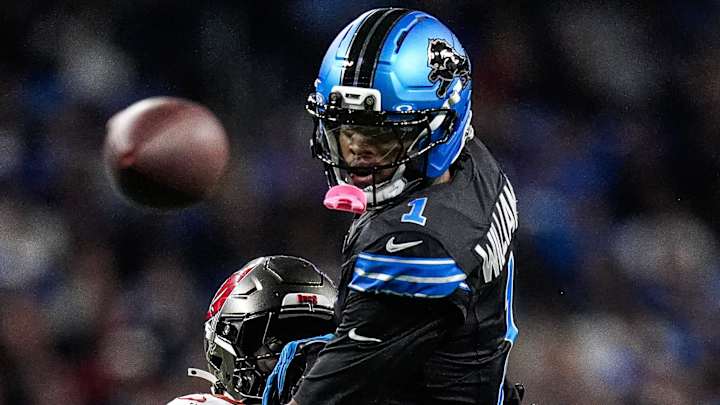Despite a quiet outing in Detroit’s overtime thriller, encouraging indicators show the Lions’ deep-threat receiver remains an important — and properly utilized — piece of the offense.
Lions’ Win Overshadows Concerns About Williams’ Usage
The Detroit Lions escaped Week 12 with a roller-coaster 34–27 overtime win over the Jameis Winston-led New York Giants, and while the victory pushed Detroit to 7–4, one storyline had fans buzzing for all the wrong reasons: Jameson Williams’ disappearance from the box score.
Williams finished the game with zero receptions on three targets, a stat that immediately sparked questions about his role, his usage, and whether the Lions were underutilizing the receiver they committed $83 million to this offseason.
But a closer look at Detroit’s season — and Williams’ unique skill set — actually paints a far more encouraging picture.
Why Williams’ Low-Volume Role Isn’t a Red Flag
Strangely enough, the Lions’ success this year has lined up almost perfectly with games where Williams sees limited targets.
Detroit is 5–0 when Williams receives four or fewer targets, but just 2–4 when he sees at least five.
That trend isn’t about ability — it’s about identity.
Williams’ game is built on explosiveness, not volume. He’s not designed to command the same steady workload as Amon-Ra St. Brown or Jahmyr Gibbs, who thrive with touches in bunches. Instead, Williams excels as a home-run threat, a receiver whose value spikes when defenses forget about him long enough for Detroit to take a deep shot.
And the numbers prove it:
- Leads the team in yards per target (10.6)
- A staggering 16.3 yards per touch, far ahead of every Lion with 5+ touches
- (LaPorta: 12.2
- St. Brown: 11.4)
Forcing the ball to a player built on efficiency rather than volume doesn’t unlock his talent — it dilutes it. The Lions seem to understand that.
Coaching Staff Sends Clear Message: Use Williams When He’s Most Dangerous
Detroit didn’t hand Williams a long-term extension because they believed he would overtake St. Brown or Gibbs as the focal point of the offense. They paid him because he’s the perfect complement — the piece that makes defenses hesitate, stretch, and think twice.
His Week 12 stat line doesn’t reflect diminishing trust — it reflects proper usage.
Dan Campbell, who never shies away from tough conversations, isn’t a coach who forces targets to justify contracts. He’s the kind of coach who builds roles that help the team win. And Williams, by all indications, is fully on board with that approach.
Campbell has the cultural command to address any frustration before it becomes a distraction, and Williams’ understanding of his strengths — and his place within a playoff-chasing offense — is one of the strongest indicators that Week 12 concerns are overblown.
The Bigger Picture: Williams Is Still a Key Weapon
This wasn’t a sign of regression — it was a reminder of who Jameson Williams is and how Detroit wins with him.
When used selectively, he stretches the field.
When defenses relax, he punishes them.
When the Lions stay balanced, he becomes exponentially more dangerous.
Detroit doesn’t need to feed Williams 10 targets to justify his role.
They need him to do exactly what he does best — strike when the moment arrives.
And as long as the Lions remain in control of his usage rather than chasing numbers, the signs are overwhelmingly positive for Williams and Detroit’s long-term offensive outlook.
